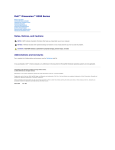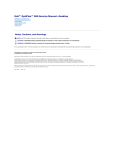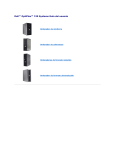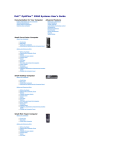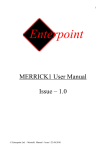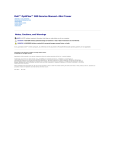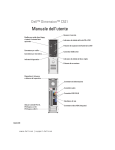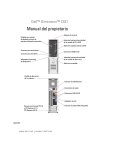Download Dell Precision N8152 User's Manual
Transcript
N8152bk1.book Page 1 Wednesday, May 25, 2005 3:08 PM Dell Precision™ Workstation 380 Quick Reference Guide Model DCTA w w w. d e l l . c o m | s u p p o r t . d e l l . c o m N8152bk1.book Page 2 Wednesday, May 25, 2005 3:08 PM Notes, Notices, and Cautions NOTE: A NOTE indicates important information that helps you make better use of your computer. NOTICE: A NOTICE indicates either potential damage to hardware or loss of data and tells you how to avoid the problem. CAUTION: A CAUTION indicates a potential for property damage, personal injury, or death. Abbreviations and Acronyms For a complete list of abbreviations and acronyms, see the Glossary in your User’s Guide. If you purchased a Dell™ n Series computer, any references in this document to Microsoft® Windows® operating systems are not applicable. ____________________ Information in this document is subject to change without notice. © 2005 Dell Inc. All rights reserved. Reproduction in any manner whatsoever without the written permission of Dell Inc. is strictly forbidden. Trademarks used in this text: Dell, the DELL logo, and Dell Precision are trademarks of Dell Inc.; Intel and Pentium are registered trademarks of Intel Corporation; Microsoft and Windows are registered trademarks of Microsoft Corporation. Other trademarks and trade names may be used in this document to refer to either the entities claiming the marks and names or their products. Dell Inc. disclaims any proprietary interest in trademarks and trade names other than its own. Model DCTA May 2005 P/N N8152 Rev. A01 N8152bk1.book Page 3 Wednesday, May 25, 2005 3:08 PM Contents Finding Information . . . . . . . . . . . . . . . . . . . . . . . . . . . . . . . . 5 . . . . . . . . . . . . . . . . . . 9 Setting Up Your Computer (Tower Orientation) Setting Up Your Computer (Desktop Orientation) . About Your Computer. . . . . . . . . . . . . . . . 14 . . . . . . . . . . . . . . . . . . . . . . . . . . . . . . 19 Front View (Tower Orientation) . . Back View (Tower Orientation) . . Front View (Desktop Orientation) . Back View (Desktop Orientation) . Back-Panel Connectors . . . . . Inside View . . . . . . . . . . . . . . . . . . . . . . . . . . . . . . . . . . . . . . . . . . . . . . . . . . . . . . 19 21 22 24 24 27 System Board Components. . . . . . . . . . . . . . . . . . . . . . . . . . . . 28 Locating Your User’s Guide . . . . . . . . . . . . . . . . . . . . . . . . . . . 29 Removing the Computer Cover . . . . . . . . . . . . . . . . . . . . . . . . . . . . . . . . . . . . . . . . . . . . . . . . . . . . . . . . . . . . . . . . . . . . . . . . . . . . . . . . . . . . . . . . . 30 . . . . . . . . . . . . . . . . . . . . . . . . . . . . 31 . . . . . . . . . . . . . . . . . . . . . . . . . . . . . . . . 32 Caring for Your Computer Solving Problems . . . . . . . . . . . . . . . . . . . . . Troubleshooting Tips . . . . . . . . . . . . . . . . . Resolving Software and Hardware Incompatibilities Using Microsoft® Windows® XP System Restore . . Using the Last Known Good Configuration . . . . . . Dell Diagnostics . . . . . . . . . . . . . . . . . . . . Before You Start Testing . . . . . . . . . . . . . . . Beep Codes . . . . . . . . . . . . 32 32 32 34 34 36 . . . . . . . . . . . . . . . . . . . . . . . . . . . . . . . . . . . 36 Error Messages . Diagnostic Lights. . . . . . . . . . . . . . . . . . . . . . . . . . . . . . . . . . . . . . . . . . . . . . . . . . . . . . . . . . . . . . . . 37 . . . . . . . . . . . . . . . . . . . . . . . . . . . . . . . . 37 Frequently Asked Questions . Index . . . . . . . . . . . . . . . . . . . . . . . . . . . . . . . . . . . . . . . . . . . . . . . . . 42 . . . . . . . . . . . . . . . . . . . . . . . . . . . . . . . . . . . . . . . . 45 Contents 3 N8152bk1.book Page 4 Wednesday, May 25, 2005 3:08 PM 4 Contents N8152bk1.book Page 5 Wednesday, May 25, 2005 3:08 PM Finding Information NOTE: Some features may not be available for your computer or in certain countries. NOTE: Additional information may ship with your computer. What Are You Looking For? Find It Here • • • • • Drivers and Utilities CD (also known as ResourceCD) A diagnostic program for my computer Drivers for my computer My computer documentation My device documentation Desktop System Software (DSS) Documentation and drivers are already installed on your computer. You can use the CD to reinstall drivers, run the "Dell Diagnostics" on page 34, or access your documentation. Readme files may be included on your CD to provide last-minute updates about technical changes to your computer or advanced technical-reference material for technicians or experienced users. NOTE: Drivers and documentation updates can be found at support.dell.com. • • • • • • • How to set up my computer How to care for my computer Basic troubleshooting information How to run the Dell Diagnostics Error codes and diagnostic lights How to remove and install parts How to open my computer cover Quick Reference Guide NOTE: This document is available as a PDF at support.dell.com. Quick Reference Guide 5 www.dell.com | support.dell.com N8152bk1.book Page 6 Wednesday, May 25, 2005 3:08 PM What Are You Looking For? Find It Here • • • • • • Warranty information Terms and Conditions (U.S. only) Safety instructions Regulatory information Ergonomics information End User License Agreement Dell™ Product Information Guide • • • • How to remove and replace parts Specifications How to configure system settings How to troubleshoot and solve problems User’s Guide Microsoft® Windows® XP Help and Support Center 1 Click the Start button and click Help and Support. 2 Click User’s and system guides and click User’s guides. The User’s Guide is also available on the Drivers and Utilities CD. • Service Tag and Express Service Code • Microsoft Windows License Label Service Tag and Microsoft® Windows® License These labels are located on your computer. • Use the Service Tag to identify your computer when you use support.dell.com or contact technical support. • Enter the Express Service Code to direct your call when contacting technical support. 6 Quick Reference Guide N8152bk1.book Page 7 Wednesday, May 25, 2005 3:08 PM What Are You Looking For? Find It Here • Solutions — Troubleshooting hints and tips, articles from technicians, online courses, frequently asked questions • Community — Online discussion with other Dell customers • Upgrades — Upgrade information for components, such as memory, the hard drive, and the operating system • Customer Care — Contact information, service call and order status, warranty, and repair information • Service and support — Service call status and support history, service contract, online discussions with technical support • Reference — Computer documentation, details on my computer configuration, product specifications, and white papers • Downloads — Certified drivers, patches, and software updates • Desktop System Software (DSS) — If you reinstall the operating system for your computer, you should also reinstall the DSS utility. DSS provides critical updates for your operating system and support for Dell™ 3.5-inch USB floppy drives, Intel® Pentium® M processors, optical drives, and USB devices. DSS is necessary for correct operation of your Dell computer. The software automatically detects your computer and operating system and installs the updates appropriate for your configuration. To download Desktop System Software: 1 Go to support.dell.com and click Downloads. 2 Enter your Service Tag or product model. 3 In the Download Category drop-down menu, click All. 4 Select the operating system and operating system language for your computer, and click Submit. Under Select a Device, scroll to System and Configuration Utilities, and click Dell Desktop System Software. Dell Support Website — support.dell.com NOTE: Select your region to view the appropriate support site. NOTE: Corporate, government, and education customers can also use the customized Dell Premier Support website at premier.support.dell.com. The website may not be available in all regions. • How to use Windows XP • Documentation for my computer • Documentation for devices (such as a modem) Windows Help and Support Center 1 Click the Start button and click Help and Support. 2 Type a word or phrase that describes your problem and click the arrow icon. 3 Click the topic that describes your problem. 4 Follow the instructions on the screen. Quick Reference Guide 7 www.dell.com | support.dell.com N8152bk1.book Page 8 Wednesday, May 25, 2005 3:08 PM What Are You Looking For? Find It Here • How to reinstall my operating system Operating System CD The operating system is already installed on your computer. To reinstall your operating system, use the Operating System CD. See your User’s Guide for instructions. After you reinstall your operating system, use the optional Drivers and Utilities CD to reinstall drivers for the devices that came with your computer. Your operating system product key label is located on your computer. NOTE: The color of your CD varies based on the operating system you ordered. NOTE: The Operating System CD is optional and may not ship with your computer. • How to use Linux • E-mail discussions with users of Dell Precision™ products and the Linux operating system • Additional information regarding Linux and my Dell Precision computer 8 Quick Reference Guide Dell Supported Linux Sites • Linux.dell.com • Lists.us.dell.com/mailman/listinfo/linux-precision • Docs.us.dell.com/docs/software/oslinux/ N8152bk1.book Page 9 Wednesday, May 25, 2005 3:08 PM Setting Up Your Computer (Tower Orientation) CAUTION: Before you begin any of the procedures in this section, follow the safety instructions in the Product Information Guide. You must complete all steps to properly set up your computer. 1 Connect the keyboard and the mouse. PS/2 or USB PS/2 or USB 2 Connect the modem or the network cable. NOTICE: Do not connect a modem cable to the network adapter. Voltage from telephone communications can damage the network adapter. Network NOTE: If your computer has a network card installed, connect the network cable to the card. Modem Quick Reference Guide 9 www.dell.com | support.dell.com N8152bk1.book Page 10 Wednesday, May 25, 2005 3:08 PM 3 Connect the monitor. Depending on your graphics card, you can connect your monitor in various ways. NOTE: You may need to use the provided adapter or cable to connect your monitor to the computer. 10 Quick Reference Guide N8152bk1.book Page 11 Wednesday, May 25, 2005 3:08 PM For single- and dual-monitor capable cards with a single connector One VGA adapter: VGA Use the VGA adapter when you have a single-monitor graphics card and you want to connect your computer to a VGA monitor. Dual VGA Y cable adapter: VGA Dual DVI Y cable adapter: DVI VGA DVI Use the appropriate Y cable when your graphics card has a Use the appropriate Y cable when your graphics card has a single connector and you want to connect your computer single connector and you want to connect your computer to one or two VGA monitors. to one or two DVI monitors. The dual-monitor cable is color-coded; the blue connector is for the primary monitor, and the black connector is for the second monitor. To enable dual-monitor support, both monitors must be attached to the computer when you start the computer. Quick Reference Guide 11 www.dell.com | support.dell.com N8152bk1.book Page 12 Wednesday, May 25, 2005 3:08 PM For dual-monitor capable cards with one DVI connector and one VGA connector One DVI connector and one VGA connector: Two VGA connectors with one VGA adapter: DVI VGA VGA VGA Use the appropriate connector(s) when you want to connect your computer to one or two monitors. Use the VGA adapter when you want to connect your computer to two VGA monitors. For dual-monitor capable cards with two DVI connectors Two DVI connectors with one VGA adapter: Two DVI connectors: DVI Two DVI connectors with two VGA adapters: DVI DVI VGA Use the DVI connectors to connect your computer to one or two DVI monitors. 12 Quick Reference Guide Use the VGA adapter to connect a VGA monitor to one of the DVI connectors on your computer VGA VGA Use two VGA adapters to connect two VGA monitors to the DVI connectors on your computer. N8152bk1.book Page 13 Wednesday, May 25, 2005 3:08 PM 4 Connect the speakers. NOTE: If your computer has a sound card installed, connect the speakers to the card. LINE OUT 5 Connect the power cables and turn on the computer and monitor. 1 2 3 4 Quick Reference Guide 13 www.dell.com | support.dell.com N8152bk1.book Page 14 Wednesday, May 25, 2005 3:08 PM 6 Install additional software or devices. Before you install any devices or software that did not come with your computer, read the documentation that came with the software or device or contact the vendor to verify that the software or device is compatible with your computer and operating system. You have now completed the setup for your tower computer. Setting Up Your Computer (Desktop Orientation) CAUTION: Before you begin any of the procedures in this section, follow the safety instructions in the Product Information Guide. You must complete all steps to properly set up your computer. 1 Connect the keyboard and the mouse. PS/2 NOTICE: Do not connect a modem cable to the network adapter. Voltage from telephone communications can damage the network adapter. USB PS/2 or 14 Quick Reference Guide or USB N8152bk1.book Page 15 Wednesday, May 25, 2005 3:08 PM 2 Connect the modem or the network cable. NOTE: If your computer has a network card installed, connect the network cable to the card. 3 Modem Network Connect the monitor. Depending on your graphics card, you can connect your monitor in various ways. NOTE: You may need to use the provided adapter or cable to connect your monitor to the computer. Quick Reference Guide 15 www.dell.com | support.dell.com N8152bk1.book Page 16 Wednesday, May 25, 2005 3:08 PM For single- and dual-monitor capable cards with a single connector VGA adapter: VGA Use the VGA adapter when you have a single monitor graphics card and you want to connect your computer to a VGA monitor. Dual VGA Y cable adapter: VGA Dual DVI Y cable adapter: DVI VGA DVI Use the appropriate Y cable when your graphics card has a Use the appropriate Y cable when your graphics card has a single connector and you want to connect your computer single connector and you want to connect your computer to one or two VGA monitors. to one or two DVI monitors. The dual-monitor cable is color-coded; the blue connector is for the primary monitor, and the black connector is for the second monitor. To enable dual-monitor support, both monitors must be attached to the computer when you start your computer. 16 Quick Reference Guide N8152bk1.book Page 17 Wednesday, May 25, 2005 3:08 PM For dual-monitor capable cards with one DVI connector and one VGA connector One DVI connector and one VGA connector: Two VGA connectors with one VGA adapter: DVI VGA VGA VGA Use the appropriate connector(s) when you want to connect your computer to one or two monitors. Use the VGA adapter when you want to connect your computer to two VGA monitors. For dual-monitor capable cards with two DVI connectors Two DVI connectors: Two DVI connectors with one VGA adapter: DVI Two DVI connectors with two VGA adapters: DVI DVI VGA Use the DVI connector(s) to connect your computer to one or two DVI monitors. Use the VGA adapter to connect a VGA monitor to one of the DVI connectors on your computer. VGA VGA Use two VGA adapters to connect two VGA monitors to the DVI connectors on your computer. Quick Reference Guide 17 www.dell.com | support.dell.com N8152bk1.book Page 18 Wednesday, May 25, 2005 3:08 PM 4 Connect the speakers. LINE OUT NOTE: If your computer has a sound card installed, connect the speakers to the card. 5 Connect the power cables and turn on the computer and monitor. Your desktop computer has an optional front IEEE 1394 connector. This connector is only available if you purchased an IEEE 1394 card. To purchase a card, contact Dell. For instructions on contacting Dell and for more information on the IEEE 1394 card, see your User’s Guide. 6 4 3 2 1 Install additional software or devices. Before you install any devices or software that did not come with your computer, read the documentation that came with the software or device or contact the vendor to verify that the software or device is compatible with your computer and operating system. You have now completed the setup for your desktop computer. 18 Quick Reference Guide N8152bk1.book Page 19 Wednesday, May 25, 2005 3:08 PM About Your Computer Front View (Tower Orientation) 1 14 2 13 3 4 5 12 11 6 1 2 3 4 10 7 9 8 1 upper 5.25-inch drive bay Holds a CD/DVD drive. 2 lower 5.25-inch drive bay Holds a CD/DVD drive or an optional third hard drive. 3 upper 3.5-inch drive bay Holds an optional fourth hard drive (serial ATA). 4 lower 3.5-inch drive bay You can use the bay for an optional floppy drive or an optional Media Card Reader. 5 hard-drive activity light The hard drive light is on when the computer reads data from or writes data to the hard drive. The light might also be on when a device such as your CD player is operating. Quick Reference Guide 19 www.dell.com | support.dell.com N8152bk1.book Page 20 Wednesday, May 25, 2005 3:08 PM 6 IEEE 1394 connector (optional) Use the optional IEEE 1394 connectors for high-speed data devices such as digital video cameras and external storage devices. 7 USB 2.0 connectors (2) Use the front USB connectors for devices that you connect occasionally, such as flash memory keys or cameras, or for bootable USB devices (see system setup for more information on booting to a USB device). It is recommended that you use the back USB connectors for devices that typically remain connected, such as printers and keyboards. 8 Dell™ badge rotation notch To rotate, place fingers around the outside of the badge, press in, and turn the badge. You can also rotate the badge using the slot provided near the bottom of the badge. 9 power button Press to turn on the computer. NOTICE: To avoid losing data, do not use the power button to turn off the computer. Instead, perform an operating system shutdown. NOTE: The power button can also be used to wake the computer or to place it into a power-saving state. See "Power Management" in your User’s Guide for more information. 10 power light The power light illuminates and blinks or remains solid to indicate different states: • No light — The computer is turned off. • Steady green — The computer is in a normal operating state. • Blinking green — The computer is in a power-saving state. • Blinking or solid amber — See "Power Problems" in your User’s Guide. To exit from a power-saving state, press the power button or use the keyboard or the mouse if it is configured as a wake device in the Windows Device Manager. For more information about sleep states and exiting from a power-saving state, see "Power Management" in your User’s Guide. See "Diagnostic Lights" on page 37 for a description of light codes that can help you troubleshoot problems with your computer. 11 microphone connector Use the microphone connector to attach a personal computer microphone for voice or musical input into a sound or telephony program. 12 headphone connector Use the headphone connector to attach headphones. 13 diagnostic lights (4) Use the lights to help you troubleshoot a computer problem based on the diagnostic code. For more information, see "Diagnostic Lights" on page 37. 14 network link light The network link light is on when a good connection exists between a 10-Mbps, 100-Mbps, or 1000-Mbps (or 1-Gbps) network and the computer. 20 Quick Reference Guide N8152bk1.book Page 21 Wednesday, May 25, 2005 3:08 PM Back View (Tower Orientation) 1 2 3 4 1 power connector Insert the power cable into this connector. 2 voltage selection switch See the safety instructions in the Product Information Guide for more information. 3 back-panel connectors Plug serial, USB, and other devices into the appropriate connector. 4 card slots Access connectors for any installed PCI or PCI Express cards. Quick Reference Guide 21 N8152bk1.book Page 22 Wednesday, May 25, 2005 3:08 PM www.dell.com | support.dell.com Front View (Desktop Orientation) 1 2 3 4 5 6 7 4 3 2 1 12 11 10 9 8 1 upper 5.25-inch drive bay 2 lower 5.25-inch drive bay This bay holds an optional CD/DVD drive or an optional third hard drive (serial ATA or SCSI). 3 3.5-inch drive bay You can use the bay for a floppy drive or an optional Media Card Reader. 4 hard-drive activity light The hard-drive activity light is on when the computer reads data from or writes data to the hard drive. The light might also be on when a device such as your CD player is operating. 5 IEEE 1394 connector (optional) Use the optional IEEE 1394 connectors for high-speed data devices such as digital video cameras and external storage devices. 22 Quick Reference Guide This bay holds a CD/DVD drive. N8152bk1.book Page 23 Wednesday, May 25, 2005 3:08 PM 6 USB 2.0 connectors (2) Use the front USB connectors for devices that you connect occasionally, such as flash memory keys or cameras, or for bootable USB devices (see system setup for more information on booting to a USB device). It is recommended that you use the back USB connectors for devices that typically remain connected, such as printers and keyboards. 7 power button Press to turn on the computer. NOTE: The power button can also be used to wake the computer or to place it into a power-saving state. See "Power Management" for more information. NOTICE: To avoid losing data, do not use the power button to turn off the computer. Instead, perform an operating system shutdown. 8 power light The power light illuminates and blinks or remains solid to indicate different states: • No light — The computer is turned off. • Steady green — The computer is in a normal operating state. • Blinking green — The computer is in a power-saving state. • Blinking or solid amber — See "Power Problems." To exit from a power-saving state, press the power button or use the keyboard or the mouse if it is configured as a wake device in the Windows Device Manager. For more information about sleep states and exiting from a power-saving state, see "Power Management." See "Diagnostic Lights" on page 37 for a description of light codes that can help you troubleshoot problems with your computer. 9 diagnostic lights (4) Use the lights to help you troubleshoot a computer problem based on the diagnostic code. For more information, see "Diagnostic Lights" on page 37. 10 microphone connector Use the microphone connector to attach a personal computer microphone for voice or musical input into a sound or telephony program. 11 headphone connector Use the headphone connector to attach headphones. 12 network link light The network link light is on when a good connection exists between a 10-Mbps, 100-Mbps, or 1000-Mbps (or 1-Gbps) network and the computer. Quick Reference Guide 23 N8152bk1.book Page 24 Wednesday, May 25, 2005 3:08 PM www.dell.com | support.dell.com Back View (Desktop Orientation) 1 2 3 4 1 card slots Access connectors for any installed PCI or PCI Express cards. 2 power connector Insert the power cable into this connector. 3 voltage selection switch See the safety instructions in the Product Information Guide for more information. 4 back-panel connectors Plug serial, USB, and other devices into the appropriate connector. Back-Panel Connectors 1 2 3 4 5 6 7 8 12 24 Quick Reference Guide 11 10 9 N8152bk1.book Page 25 Wednesday, May 25, 2005 3:08 PM 1 mouse connector Plug a standard mouse into the green mouse connector. Turn off the computer and any attached devices before you connect a mouse to the computer. If you have a USB mouse, plug it into a USB connector. If your computer is running the Microsoft® Windows XP operating system, the necessary mouse drivers have been installed on your hard drive. 2 parallel connector Connect a parallel device, such as a printer, to the parallel connector. If you have a USB printer, plug it into a USB connector. NOTE: The integrated parallel connector is automatically disabled if the computer detects an installed card containing a parallel connector configured to the same address. For more information, see "System Setup Options" in the User’s Guide. 3 link integrity light • Green — A good connection exists between a 10-Mbps network and the computer. • Orange — A good connection exists between a 100-Mbps network and the computer. • Yellow — A good connection exists between a 1000-Mbps (or 1-Gbps) network and the computer. • Off — The computer is not detecting a physical connection to the network. 4 network adapter connector To attach your computer to a network or broadband device, connect one end of a network cable to either a network jack or your network or broadband device. Connect the other end of the network cable to the network adapter connector on your computer. A click indicates that the network cable has been securely attached. NOTE: Do not plug a telephone cable into the network connector. On computers with an additional network connector card, use the connectors on the card and on the back of the computer when setting up multiple network connections (such as a separate intra- and extranet). It is recommended that you use Category 5 wiring and connectors for your network. If you must use Category 3 wiring, force the network speed to 10 Mbps to ensure reliable operation. 5 network activity light Flashes a yellow light when the computer is transmitting or receiving network data. A high volume of network traffic may make this light appear to be in a steady "on" state. Quick Reference Guide 25 www.dell.com | support.dell.com N8152bk1.book Page 26 Wednesday, May 25, 2005 3:08 PM 6 line-in connector Use the blue line-in connector to attach a record/playback device such as a cassette player, CD player, or VCR. On computers with a sound card, use the connector on the card. 7 line-out connector 8 microphone connector Use the green line-out connector to attach headphones and most speakers with integrated amplifiers. On computers with a sound card, use the connector on the card. Use the pink microphone connector to attach a personal computer microphone for voice or musical input into a sound or telephony program. On computers with a sound card, the microphone connector is on the card. 9 USB 2.0 connectors (2) Use the back USB connectors for devices that typically remain connected, such as printers and keyboards. It is recommended that you use the front USB connectors for devices that you connect occasionally, such as flash memory keys or cameras, or for bootable USB devices. 10 USB 2.0 connectors (3) Use the back USB connectors for devices that typically remain connected, such as printers and keyboards. It is recommended that you use the front USB connectors for devices that you connect occasionally, such as flash memory keys or cameras, or for bootable USB devices. 11 serial connector 12 keyboard connector Connect a serial device, such as a handheld device, to the serial port. The default designations are COM1 for serial connector 1 and COM2 for the optional serial connector 2. For more information, see "System Setup Options" in the User’s Guide. 26 Quick Reference Guide If you have a standard keyboard, plug it into the purple keyboard connector. If you have a USB keyboard, plug it into a USB connector. N8152bk1.book Page 27 Wednesday, May 25, 2005 3:08 PM Inside View CAUTION: Before you begin any of the procedures in this section, follow the safety instructions in the Product Information Guide. 1 2 3 10 9 4 5 8 6 7 1 power supply 6 card fan 2 optional additional fan 7 processor fan 3 system board 8 lower 3.5-inch drive bay 4 hard drive 9 upper 5.25-inch drive bay 5 processor airflow shroud 10 hard drive cage Quick Reference Guide 27 N8152bk1.book Page 28 Wednesday, May 25, 2005 3:08 PM www.dell.com | support.dell.com Cable Colors Device Color Hard drive blue cable Floppy drive black pull tab CD/DVD drive orange pull tab System Board Components 1 2 3 4 5 6 7 23 8 9 10 11 22 12 13 14 21 20 15 19 28 Quick Reference Guide 18 17 16 N8152bk1.book Page 29 Wednesday, May 25, 2005 3:08 PM 1 power connector (12VPOWER) 13 PCI-Express x1 card slot 2 memory module connectors 14 PCI-Express x16 up to 150w card slot 3 battery socket (BATTERY) 15 PCI-Express x8 card slot (wired as x4) 4 memory fan connector (FAN_MEM) 16 PCI card slots (1-3) 5 front panel connector 17 external light connector (AUX LED) 6 main power connector (POWER) 18 floppy drive (FLOPPY) 7 IDE drive connector (IDE) 19 serial connector (SERIAL2) 8 SATA connectors (SATA-1, SATA-3, SATA-0, SATA-2) 20 card cage fan (FAN CARD CAGE) 9 RTC reset jumper (RTCRST) 21 internal speaker connector (INT_SPKR) 10 Flexbay connector (FLEXBAY) 22 processor fan connector (FAN_CPU) 11 chassis intrusion header 23 processor connector (CPU) 12 password jumper (PASS) Locating Your User’s Guide Your User’s Guide contains additional information about your computer such as: • Technical specifications • Information for changing the orientation of your computer from a desktop to a tower • Front and back views of your computer, including all of the available connectors • Inside views of your computer, including a detailed graphic of the system board and the connectors • Instructions for cleaning your computer • Information on software features, such as LegacySelect Technology control, using a password, and system setup options • Tips and information for using the Microsoft Windows XP operating system • Instructions for removing and installing parts, including memory, cards, drives, the microprocessor, and the battery • Information for troubleshooting various computer problems • Instructions for using the Dell Diagnostics and reinstalling drivers • Information on how to contact Dell You can access the User’s Guide from your hard drive or the Dell Support website at support.dell.com. Quick Reference Guide 29 N8152bk1.book Page 30 Wednesday, May 25, 2005 3:08 PM www.dell.com | support.dell.com To access the User’s Guide from your hard drive: Click the Start button and click Help and Support. To access your User’s Guide from the Dell Support website: 1 Go to support.dell.com. 2 Follow the prompts on the website that ask you for information specific to your computer. 3 At the Dell Support website home page, click Reference, click User’s Guides, click Systems, and then select your computer. Removing the Computer Cover CAUTION: Before you begin any of the procedures in this section, follow the safety instructions in the Product Information Guide. CAUTION: To guard against electrical shock, always unplug your computer from the electrical outlet before removing the cover. NOTICE: Before touching anything inside your computer, ground yourself by touching an unpainted metal surface, such as the metal at the back of the computer. While you work, periodically touch an unpainted metal surface to dissipate any static electricity that could harm internal components. NOTICE: To avoid losing data, save and close any open files and exit any open programs before you turn off your computer. 1 Shut down the operating system: a Save and close any open files, exit any open programs, click the Start button, and then click Turn Off Computer. b In the Turn off computer window, click Turn off. The computer turns off after the operating system shutdown process finishes. 2 Ensure that the computer and any attached devices are turned off. If your computer and attached devices did not automatically turn off when you shut down your operating system, turn them off now. 3 If you have installed a security cable, remove it from the security cable slot. NOTICE: Ensure that you are working on a level, protected surface to avoid scratching either the computer or the surface on which it is resting. 4 Lay your computer on a flat surface with the computer cover facing up. 5 Pull back the cover latch release. 30 Quick Reference Guide N8152bk1.book Page 31 Wednesday, May 25, 2005 3:08 PM cover latch release computer cover hinge tabs (3) 6 Locate the three hinge tabs on the edge of the computer. 7 Grip the sides of the computer cover and pivot the cover up, using the hinges as leverage points. 8 Release the cover from the hinge tabs and set it aside in a secure location. Caring for Your Computer To help maintain your computer, follow these suggestions: • To avoid losing or corrupting data, never turn off your computer when the hard drive light is on. • Schedule regular virus scans using virus software. • Manage hard drive space by periodically deleting unnecessary files and defragmenting the drive. • Back up files on a regular basis. • Periodically clean your monitor screen, mouse, and keyboard (see your User’s Guide for more information). Quick Reference Guide 31 N8152bk1.book Page 32 Wednesday, May 25, 2005 3:08 PM www.dell.com | support.dell.com Solving Problems Troubleshooting Tips Perform the following checks when you troubleshoot your computer: • If you added or removed a part before the problem started, review the installation procedures and ensure that the part is correctly installed. • If a peripheral device does not work, ensure that the device is properly connected. • If an error message appears on the screen, write down the exact message. The message may help technical support personnel diagnose and fix the problem(s). • If an error message occurs in a program, see the program’s documentation. • If the recommended action in the troubleshooting section is to see a section in your User’s Guide, go to support.dell.com (on another computer if necessary) to access your User’s Guide. Resolving Software and Hardware Incompatibilities If a device is either not detected during the operating system setup or is detected but incorrectly configured, you can use the Hardware Troubleshooter to resolve the incompatibility. To resolve incompatibilities using the Hardware Troubleshooter: 1 Click the Start button and click Help and Support. 2 Type hardware troubleshooter in the Search field and click the arrow to start the search. 3 Click Hardware Troubleshooter in the Search Results list. 4 In the Hardware Troubleshooter list, click I need to resolve a hardware conflict on my computer, and click Next. Using Microsoft® Windows® XP System Restore The Microsoft Windows XP operating system provides System Restore to allow you to return your computer to an earlier operating state (without affecting data files) if changes to the hardware, software, or other system settings have left the computer in an undesirable operating state. See the Windows Help and Support Center (see "Finding Information" on page 5) for information about using System Restore. NOTICE: Make regular backups of your data files. System Restore does not monitor your data files or recover them. Creating a Restore Point 1 Click the Start button and click Help and Support. 2 Click System Restore. 3 Follow the instructions on the screen. 32 Quick Reference Guide N8152bk1.book Page 33 Wednesday, May 25, 2005 3:08 PM Restoring the Computer to an Earlier Operating State NOTICE: Before you restore the computer to an earlier operating state, save and close any open files and exit any open programs. Do not alter, open, or delete any files or programs until the system restoration is complete. 1 Click the Start button, point to All Programs→ Accessories→ System Tools, and then click System Restore. 2 Ensure that Restore my computer to an earlier time is selected and click Next. 3 Click a calendar date to which you want to restore your computer. The Select a Restore Point screen provides a calendar that allows you to see and select restore points. All calendar dates with available restore points appear in boldface type. 4 Select a restore point and click Next. If a calendar date has only one restore point, then that restore point is automatically selected. If two or more restore points are available, click the restore point that you prefer. 5 Click Next. The Restoration Complete screen appears after System Restore finishes collecting data and then the computer restarts. 6 After the computer restarts, click OK. To change the restore point, you can either repeat the steps using a different restore point, or you can undo the restoration. Undoing the Last System Restore NOTICE: Before you undo the last system restore, save and close all open files and exit any open programs. Do not alter, open, or delete any files or programs until the system restoration is complete. 1 Click the Start button, point to All Programs→ Accessories→ System Tools, and then click System Restore. 2 Click Undo my last restoration and click Next. 3 Click Next. The System Restore screen appears and the computer restarts. 4 After the computer restarts, click OK. Enabling System Restore If you reinstall Windows XP with less than 200 MB of free hard-disk space available, System Restore is automatically disabled. To see if System Restore is enabled: 1 Click the Start button and click Control Panel. 2 Click Performance and Maintenance. 3 Click System. Quick Reference Guide 33 N8152bk1.book Page 34 Wednesday, May 25, 2005 3:08 PM www.dell.com | support.dell.com 4 Click the System Restore tab. 5 Ensure that Turn off System Restore is unchecked. Using the Last Known Good Configuration 1 Restart your computer and press <F8> when the message Please select the operating system to start appears. 2 Highlight Last Known Good Configuration, press <Enter>, press <l>, and then select your operating system when prompted. Other Options to Help Resolve Additional Device or Software Conflicts NOTICE: The following processes erase all of the information on your hard drive. • Reinstall your operating system using the operating system installation guide and Operating System CD. During the operating system reinstallation, you can select to delete the existing partitions and reformat your hard drive. • Reinstall all drivers, beginning with the chipset, using the Drivers and Utilities CD. Dell Diagnostics CAUTION: Before you begin any of the procedures in this section, follow the safety instructions in the Product Information Guide. When to Use the Dell Diagnostics If you experience a problem with your computer, perform the checks in "Solving Problems" on page 32 and run the Dell Diagnostics before you contact Dell for technical assistance. It is recommended that you print these procedures before you begin. NOTICE: The Dell Diagnostics works only on Dell™ computers. Using this program with other computers can cause incorrect computer responses or result in error messages. The Dell Diagnostics allow you to: 34 • Perform quick checks or extensive tests on one or all devices • Choose how many times a test is run • Display or print test results or save them in a file • Suspend testing if an error is detected or terminate testing if a certain number of errors occur • Access online Help screens that describe the tests and how to run them • Read status messages that tell you whether tests completed successfully • Receive error messages if problems are detected Quick Reference Guide N8152bk1.book Page 35 Wednesday, May 25, 2005 3:08 PM Starting the Dell Diagnostics From Your Hard Drive 1 Turn on (or restart) your computer. 2 When the DELL™ logo appears, press <F12> immediately. NOTE: If you see a message stating that no diagnostics utility partition has been found, see "Starting the Dell Diagnostics From the Drivers and Utilities CD" on page 35. If you wait too long and the operating system logo appears, continue to wait until you see the Microsoft Windows desktop. Then shut down your computer and try again. For more information on shutting down your computer, see your User’s Guide. 3 When the boot device list appears, highlight Boot to Utility Partition and press <Enter>. 4 When the Dell Diagnostics Main Menu appears, select the test you want to run. For more information on the tests, see your User’s Guide. Starting the Dell Diagnostics From the Drivers and Utilities CD 1 Insert the Drivers and Utilities CD. 2 Shut down and restart the computer. For more information on shutting down your computer, see your User’s Guide. 3 When the DELL logo appears, press <F12> immediately. If you wait too long and the Windows logo appears, continue to wait until you see the Windows desktop. Then shut down your computer and try again. For more information on shutting down your computer, see your User’s Guide. NOTE: The next steps change the boot sequence for one time only. On the next start-up, the computer boots according to the devices specified in system setup. 4 When the boot device list appears, highlight IDE CD-ROM Device and press <Enter>. 5 Select the IDE CD-ROM Device option from the CD boot menu. 6 Select the Boot from CD-ROM option from the menu that appears. 7 Type 1 to start the ResourceCD menu. 8 Type 2 to start the Dell Diagnostics. 9 Select Run the 32 Bit Dell Diagnostics from the numbered list. If multiple versions are listed, select the version appropriate for your computer. 10 When the Dell Diagnostics Main Menu appears, select the test you want to run. For more information on the tests, see your User’s Guide. Quick Reference Guide 35 N8152bk1.book Page 36 Wednesday, May 25, 2005 3:08 PM www.dell.com | support.dell.com Before You Start Testing CAUTION: Before you begin any of the procedures in this section, follow the safety instructions in the Product Information Guide. • Turn on your printer if one is attached. • Enter system setup, review your computer’s configuration information, and enable all of your computer’s components and devices, such as connectors. Beep Codes Your computer might emit a series of beeps during start-up if the monitor cannot display errors or problems. This series of beeps, called a beep code, identifies a problem. One possible beep code (code 1-3-1) consists of one beep, a burst of three beeps, and then one beep. This beep code tells you that the computer encountered a memory problem. If a beep code is emitted, write it down and look it up in the following table. 36 Code Cause 1-1-2 Microprocessor register failure 1-1-3 NVRAM read/write failure 1-1-4 ROM BIOS checksum failure 1-2-1 Programmable interval timer failure 1-2-2 DMA initialization failure 1-2-3 DMA page register read/write failure 1-3 Video Memory Test failure 1-3-1 through 2-4-4 Memory not being properly identified or used 1-3-2 Memory problem 3-1-1 Slave DMA register failure 3-1-2 Master DMA register failure 3-1-3 Master interrupt mask register failure 3-1-4 Slave interrupt mask register failure 3-2-2 Interrupt vector loading failure 3-2-4 Keyboard Controller Test failure 3-3-1 NVRAM power loss 3-3-2 Invalid NVRAM configuration 3-3-4 Video Memory Test failure 3-4-1 Screen initialization failure Quick Reference Guide N8152bk1.book Page 37 Wednesday, May 25, 2005 3:08 PM Code Cause 3-4-2 Screen retrace failure 3-4-3 Search for video ROM failure 4-2-1 No timer tick 4-2-2 Shutdown failure 4-2-3 Gate A20 failure 4-2-4 Unexpected interrupt in protected mode 4-3-1 Memory failure above address 0FFFFh 4-3-3 Timer-chip counter 2 failure 4-3-4 Time-of-day clock stopped 4-4-1 Serial or parallel port test failure 4-4-2 Failure to decompress code to shadowed memory 4-4-3 Math-coprocessor test failure 4-4-4 Cache test failure Error Messages NOTE: If the message is not listed, see the documentation for either the operating system or the program that was running when the message appeared. If an error occurs during start-up, a message may be displayed on the monitor identifying the problem. See "Error Messages" in the User’s Guide for suggestions on resolving any problems. Diagnostic Lights CAUTION: Before you begin any of the procedures in this section, follow the safety instructions in the Product Information Guide. To help you troubleshoot a problem, your computer has four lights labeled "1," "2," "3," and "4" on the front. The lights can be off or green. When the computer starts normally, the lights flash. After the computer starts, all four lights display solid green briefly and then turn off to indicate normal operation. If the computer malfunctions, the pattern of the lights identify the problem. Light Pattern Problem Description Suggested Resolution The computer is in a normal off Plug the computer into a working condition or a possible pre-BIOS failure electrical outlet and press the power has occurred. button. NOTE: The diagnostic lights turn off after a short time if the computer is in a normal operating condition after POST. Quick Reference Guide 37 www.dell.com | support.dell.com N8152bk1.book Page 38 Wednesday, May 25, 2005 3:08 PM Light Pattern Problem Description Suggested Resolution A possible BIOS failure has occurred; the Run the BIOS Recovery utility, wait for computer is in the recovery mode. recovery completion, and then restart the computer. A possible processor failure has occurred. Reinstall the processor and restart the computer. Memory modules are detected, but a memory failure has occurred. 38 Quick Reference Guide 1 Reseat the memory modules to ensure that your computer is successfully communicating with the memory. 2 Restart the computer. 3 If the problem still exists, remove all the memory modules and install one memory module in memory module connector 4. 4 Restart the computer. The following message appears: Alert! Operating in Debug Mode. Please Populate Memory in Pairs for Normal Operation. 5 Press <F1> to boot to the operating system. 6 Run the Dell Diagnostics. See page 34 for instructions. 7 If the memory module passes, shut down the computer, remove the memory module, and then repeat the process with the remaining memory modules until a memory error occurs during start-up or diagnostic testing. If the first memory module tested is defective, repeat the process with the remaining modules to ensure that the remaining modules are not defective. 8 When the defective memory module is identified, contact Dell for a replacement. For instructions on contacting Dell, see your User’s Guide. NOTE: If necessary, the computer can operate in debug mode until new memory modules are installed. N8152bk1.book Page 39 Wednesday, May 25, 2005 3:08 PM Light Pattern Problem Description A possible expansion card failure has occurred. Suggested Resolution 1 Determine if a conflict exists by removing a card (not the graphics card) and then restarting the computer. For more information on removing a card, see your User’s Guide. 2 If the problem persists, reinstall the card that you removed, remove a different card, and then restart the computer. 3 Repeat this process for each card. If the computer starts normally, troubleshoot the last card removed from the computer for resource conflicts (see"Resolving Software and Hardware Incompatibilities" on page 32). 4 If the problem persists, contact Dell. For instructions on contacting Dell, see your User’s Guide. A possible graphics card failure has occurred. • If the computer has a graphics card, remove the card, reinstall it, and then restart the computer. • If the problem still exists, install a graphics card that you know works and restart the computer. • If the problem persists or the computer has integrated graphics, contact Dell. For instructions on contacting Dell, see your User’s Guide. A possible floppy or hard drive failure has occurred. Reseat all power and data cables and restart the computer. A possible USB failure has occurred. Reinstall all USB devices, check cable connections, and then restart the computer. Quick Reference Guide 39 www.dell.com | support.dell.com N8152bk1.book Page 40 Wednesday, May 25, 2005 3:08 PM Light Pattern Problem Description No memory modules are detected. Suggested Resolution 1 Reseat the memory modules to ensure that your computer is successfully communicating with the memory. 2 Restart the computer. 3 If the problem still exists, remove all the memory modules and install one memory module in memory module connector 4. 4 Restart the computer. The following message appears: Alert! Operating in Debug Mode. Please Populate Memory in Pairs for Normal Operation. 5 Press <F1> to boot to the operating system. 6 Run the Dell Diagnostics. See page 34 for instructions. 7 If the memory module passes, shut down the computer, remove the memory module, and then repeat the process with the remaining memory modules until a memory error occurs during start-up or diagnostic testing. If the first memory module tested is defective, repeat the process with the remaining modules to ensure that the remaining modules are not defective. 8 When the defective memory module is identified, contact Dell for a replacement.For instructions on contacting Dell, see your User’s Guide. NOTE: If necessary, the computer can operate in debug mode until new memory modules are installed. System board failure has occurred. 40 Quick Reference Guide Contact Dell for technical assistance. For instructions on contacting Dell, see your User’s Guide. N8152bk1.book Page 41 Wednesday, May 25, 2005 3:08 PM Light Pattern Problem Description Suggested Resolution Memory modules are detected, but a memory configuration or compatibility error exists. • Ensure that no special memory module/memory connector placement requirements exist. • Verify that the memory modules that you are installing are compatible with your computer. • Reinstall the memory modules and restart the computer. • If the problem persists, contact Dell. For instructions on contacting Dell, see your User’s Guide. A possible system board resource and/or hardware failure has occurred. • Perform the procedures in "Resolving Software and Hardware Incompatibilities" on page 32. • If the problem persists, contact Dell. For instructions on contacting Dell, see your User’s Guide. A possible expansion card failure has occurred. 1 Determine if a conflict exists by removing a card (not a graphics card) and restarting the computer. 2 If the problem persists, reinstall the card that you removed, remove a different card, and then restart the computer. 3 Repeat this process for each card. If the computer starts normally, troubleshoot the last card removed from the computer for resource conflicts (see "Resolving Software and Hardware Incompatibilities" on page 32). 4 If the problem persists, contact Dell. For instructions on contacting Dell, see your User’s Guide. Another failure has occurred. • Ensure that the cables are properly connected to the system board from This pattern also displays when you enter the hard drive, CD drive, and DVD system setup and may not indicate a drive. problem. • If the problem persists, contact Dell. For instructions on contacting Dell, see your User’s Guide. Quick Reference Guide 41 www.dell.com | support.dell.com N8152bk1.book Page 42 Wednesday, May 25, 2005 3:08 PM Light Pattern Problem Description Suggested Resolution The computer is in a normal operating None. condition after POST. NOTE: The diagnostic lights turn off after a short time if the computer is in a normal operating condition after POST. Frequently Asked Questions How Do I... Solution Where to Find Additional Information Set up my computer to use two monitors? If your computer has the required graphics card to support dualmonitor setup, then look in your shipping box for a Y-cable. The Y-cable has a single connector on one end (plug this connector into the back panel) and branches into two connectors (plug these connectors into the monitor cables). For the tower computer, see page 10 and for the desktop computer, see page 15. See "Setting Up Your Computer (Tower Orientation)" on page 9 or "Setting Up Your Computer (Desktop Orientation)" on page 14 for information on connecting dual monitors to your computer. Connect my monitor when the monitor cable connector doesn’t seem to fit the connector on the back of my computer? If your graphics card has a DVI connector but your monitor has a VGA connector, then you need to use an adapter. An adapter should be included in the shipping box. See "Setting Up Your Computer (Tower Orientation)" on page 9 or "Setting Up Your Computer (Desktop Orientation)" on page 14 for information on connecting monitors to your computer. For more information, contact Dell. For information on contacting Dell, see your User’s Guide. Connect my speakers? If you have a sound card installed, See the documentation that came connect the speakers to the with your speakers for more connectors on the card. For the tower information. computer, see page 13 and for the desktop computer, see page 18. 42 Quick Reference Guide N8152bk1.book Page 43 Wednesday, May 25, 2005 3:08 PM How Do I... Solution Where to Find Additional Information Find the right connectors for my USB or IEEE 1394 devices? Your tower computer has eight USB connectors (two on the front, one internal, and five on the back). See "About Your Computer" on page 19 for illustrations of the front and back views of your computer. Your desktop computer has eight USB connectors (two on the front, one internal, and five on the back) and an optional front IEEE 1394 connector. This connector is only available if you purchased an IEEE 1394 card. To purchase a card, contact Dell. For more information on the IEEE 1394 card, see your User’s Guide. For help locating your User’s Guide, see "Finding Information" on page 5. Locate information about the hardware and other technical specifications for my computer? Your User’s Guide has a specifications table that provides more detailed information about your computer and the hardware. To locate your User’s Guide, see "Finding Information" on page 5. Go to the Dell Support website at support.dell.com and use one of the following support tools: read white papers on the latest technology or communicate with other Dell users at the Dell forum chat room. Find documentation for my computer? The following documentation is available for your computer: • User’s Guide • Product Information Guide • System Information Label If you lose your documentation, it is available on the Dell Support website at support.dell.com. To locate these documents, see "Finding Information" on page 5. Quick Reference Guide 43 www.dell.com | support.dell.com N8152bk1.book Page 44 Wednesday, May 25, 2005 3:08 PM 44 Quick Reference Guide N8152bk1.book Page 45 Wednesday, May 25, 2005 3:08 PM Index B D H beep codes, 36 Dell support site, 7 hard drive activity light, 19-20, 22-23 Dell Diagnostics, 34 hardware beep codes, 36 conflicts, 32 Dell Diagnostics, 34 C cards slots, 21, 24 computer beep codes, 36 restore to previous state, 32 conflicts software and hardware incompatibilities, 32 connectors headphone, 20, 23 IEEE, 20, 22 keyboard, 26 line-in, 26 line-out, 26 microphone, 26 mouse, 25 network adapter, 25 parallel, 25 power, 21, 24 serial, 26 sound, 26 USB, 20, 23, 26 Dell Premier Support website, 6-7 diagnostic lights, 37 diagnostics beep codes, 36 Dell, 34 Drivers and Utilities CD, 5 lights, 20, 23, 37 documentation device, 5 online, 7 Product Information Guide, 6 Quick Reference, 5 ResourceCD, 5 User’s Guide, 6 drivers ResourceCD, 5 Drivers and Utilities CD, 5 E error messages beep codes, 36 diagnostic lights, 37 Hardware Troubleshooter, 32 headphone connector, 20, 23 Help and Support Center, 7 I IEEE connectors, 20, 22 installing parts turning off your computer, 30 IRQ conflicts, 32 K keyboard connector, 26 L labels Microsoft Windows, 6 Service Tag, 6 Index 45 46 N8152bk1.book Page 46 Wednesday, May 25, 2005 3:08 PM Index lights back of computer, 37 diagnostic, 20, 23, 37 hard-drive activity, 19-20, 22-23 link integrity, 25 network, 25 network activity, 25 power, 20, 23 M microphone connector, 26 Microsoft Windows label, 6 P T power button, 20, 23 connector, 21, 24 light, 20, 23 troubleshooting conflicts, 32 Dell Diagnostics, 34 diagnostic lights, 37 Hardware Troubleshooter, 32 Help and Support Center, 7 restore to previous state, 32 problems beep codes, 36 conflicts, 32 Dell Diagnostics, 34 diagnostic lights, 37 restore to previous state, 32 R U USB connector, 26 connectors, 20, 23 motherboard. See system board reinstalling Drivers and Utilities CD, 5 ResourceCD, 5 mouse connector, 25 ResourceCD Dell Diagnostics, 34 N S network connector, 25 safety instructions, 6 W Service Tag, 6 warranty, 6 O software conflicts, 32 Operating System CD, 8 Installation Guide, 8 sound connectors line-in, 26 line-out, 26 Windows XP Hardware Troubleshooter, 32 Help and Support Center, 7 System Restore, 32 system board, 28 System Restore, 32 46 Index User’s Guide, 6 V voltage selection switch, 21, 24















































